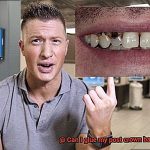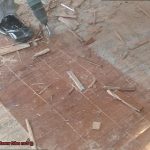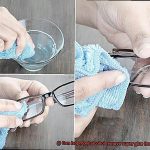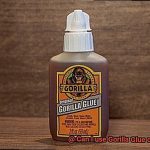Have you ever found yourself in a sticky situation, quite literally, where Gorilla Glue has stubbornly adhered to a surface? Despite your best efforts, scraping and using harsh chemicals have failed to remove it. If this sounds familiar, then you’re in luck because we’re about to explore a potential solution: WD-40.
WD-40 is the multi-use product that’s earned its reputation as a miracle worker. But can it handle Gorilla Glue? In this blog post, we’ll delve into the science behind both products to provide a definitive answer.
Firstly, we’ll examine what makes Gorilla Glue so notoriously difficult to remove. Then we’ll take a closer look at WD-40’s ingredients and how they interact with different surfaces. Armed with this knowledge, we’ll share practical steps for safely removing Gorilla Glue using WD-40.
So, if you’re tired of struggling with stubborn glue and want an effective solution, keep reading. This blog post will equip you with all the information you need to tackle any Gorilla Glue mishap with ease.
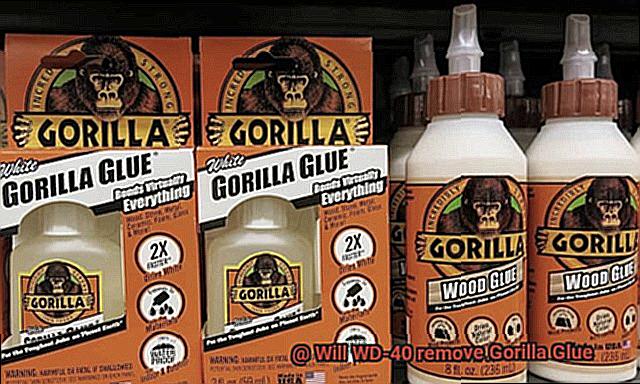
What is WD-40?
Contents
This multi-purpose spray has been around for over 60 years, and it’s a household name when it comes to DIY projects and repairs. But what exactly is WD-40, and how does it work?
Developed by chemist Norm Larsen in 1953, WD-40 stands for “water displacement – 40th attempt”. Larsen was attempting to create a rust-prevention solvent for the aerospace industry when he finally perfected the formula. The spray is made up of a mixture of petroleum-based oils, solvents, and other compounds that allow it to lubricate, clean, and protect metal surfaces from rust and corrosion.
While many people have found success using WD-40 to remove small amounts of Gorilla Glue, it’s important to note that it’s not designed to dissolve or break down adhesives. Gorilla Glue, in particular, is a polyurethane-based adhesive that forms a strong bond with surfaces. Removing it requires more than just a simple solvent or cleaner.
If you do decide to use WD-40 to remove Gorilla Glue, there are a few things to keep in mind. First, apply a generous amount of WD-40 to the affected area and allow it to sit for several minutes before attempting to remove the glue. Use a scraper or cloth to gently remove the glue from the surface, being careful not to spread it around or cause it to harden more quickly. However, this method may not work for larger amounts of glue or for surfaces that are sensitive to solvents.
What is Gorilla Glue?
It’s time to upgrade to Gorilla Glue. This brand of polyurethane-based adhesive is known for its incredible bonding capabilities and unique properties that set it apart from other adhesives.
Since its introduction in 1999, Gorilla Glue has become a popular choice for DIY enthusiasts and professionals alike. Its expanding formula fills gaps and creates a bond that can withstand even the toughest conditions. Gorilla Glue can be used on a variety of surfaces, including wood, metal, ceramic, and some plastics.
One of the standout features of Gorilla Glue is its water resistance. Once cured, it can endure exposure to both water and heat without losing its strength. This makes it an excellent choice for outdoor projects or items that will be exposed to moisture.
Gorilla Glue also dries clear, making it perfect for use on transparent or translucent surfaces. But if you want to paint or stain your project, no problem. Gorilla Glue can be sanded, painted, or stained to match your desired look.
Does WD-40 Work on Gorilla Glue?
The answer is not a simple yes or no. It depends on the type of surface or material that the Gorilla Glue is adhered to. If it’s a non-porous surface like metal or glass, then WD-40 may be effective. The solvents in WD-40 can break down the adhesive and help loosen it from the surface. Applying a generous amount of WD-40 to the area and letting it sit for several minutes before wiping away with a cloth can do the trick. Repeat this process as needed until the glue is completely removed.
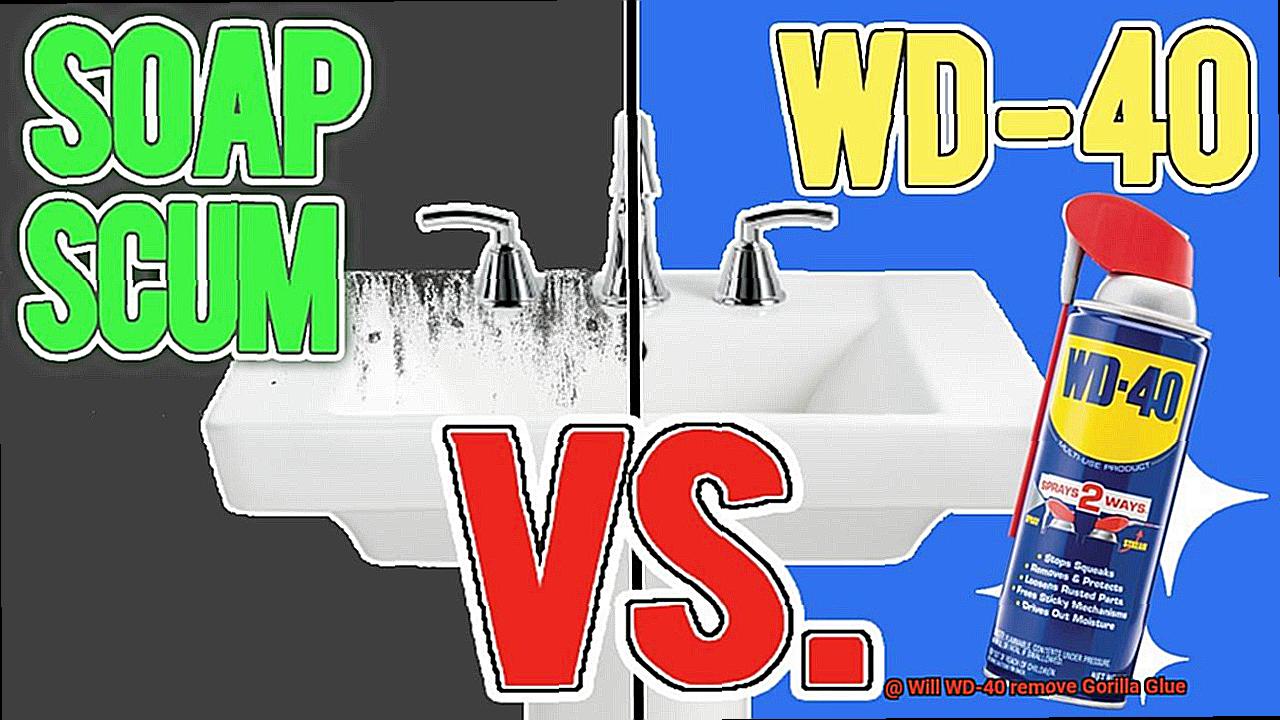
However, if the Gorilla Glue is adhered to a porous surface like wood or fabric, then WD-40 may not be as effective. The solvents in WD-40 can also damage these materials, so it’s best to avoid using it in these cases. Instead, use a specialized adhesive remover or seek professional help.
It’s important to note that WD-40 is not designed as a specialized adhesive remover and may not work on all surfaces. Therefore, before attempting to use it as an adhesive remover, consider the type of material and surface you are dealing with. In case of doubt, seek professional advice or use a specialized adhesive remover.
What to Consider Before Removing Gorilla Glue with WD-40
Gorilla Glue is a polyurethane-based adhesive that’s known for its exceptional bonding capabilities and durability. This means that removing it with WD-40 may not be as simple as spraying and wiping away. In this section, we’ll dive into some important factors to consider before attempting to remove Gorilla Glue with WD-40.
The Toughness of Gorilla Glue
Gorilla Glue is designed to be a long-lasting adhesive that can withstand wear and tear. As such, it may take more than just WD-40 to remove it completely. Before reaching for the WD-40, try using a scraper or sandpaper to remove as much of the glue as possible.
Compatibility with the Surface
WD-40 is a powerful solvent that can dissolve some materials, so it’s essential to test a small, inconspicuous area before applying it to the entire surface. If the surface is delicate or sensitive, using WD-40 may not be the best option. It’s crucial to ensure that the WD-40 won’t damage the surface you’re trying to clean.
Safety Precautions
When using any type of solvent-based product, it’s crucial to take proper safety precautions. WD-40 is flammable and can cause skin irritation or respiratory issues if not used properly. Always use the product in a well-ventilated area and wear protective gloves and eyewear.
Follow Instructions Carefully
Different WD-40 products may have different application methods, so it’s vital to read the label and follow the instructions carefully. Take note of any specific warnings or precautions listed on the label.
Consider Alternative Methods
If removing Gorilla Glue with WD-40 seems too complicated or risky, consider trying alternative methods such as using heat or acetone-based solvents. These methods may be more effective in certain situations.
How to Use WD-40 to Remove Gorilla Glue
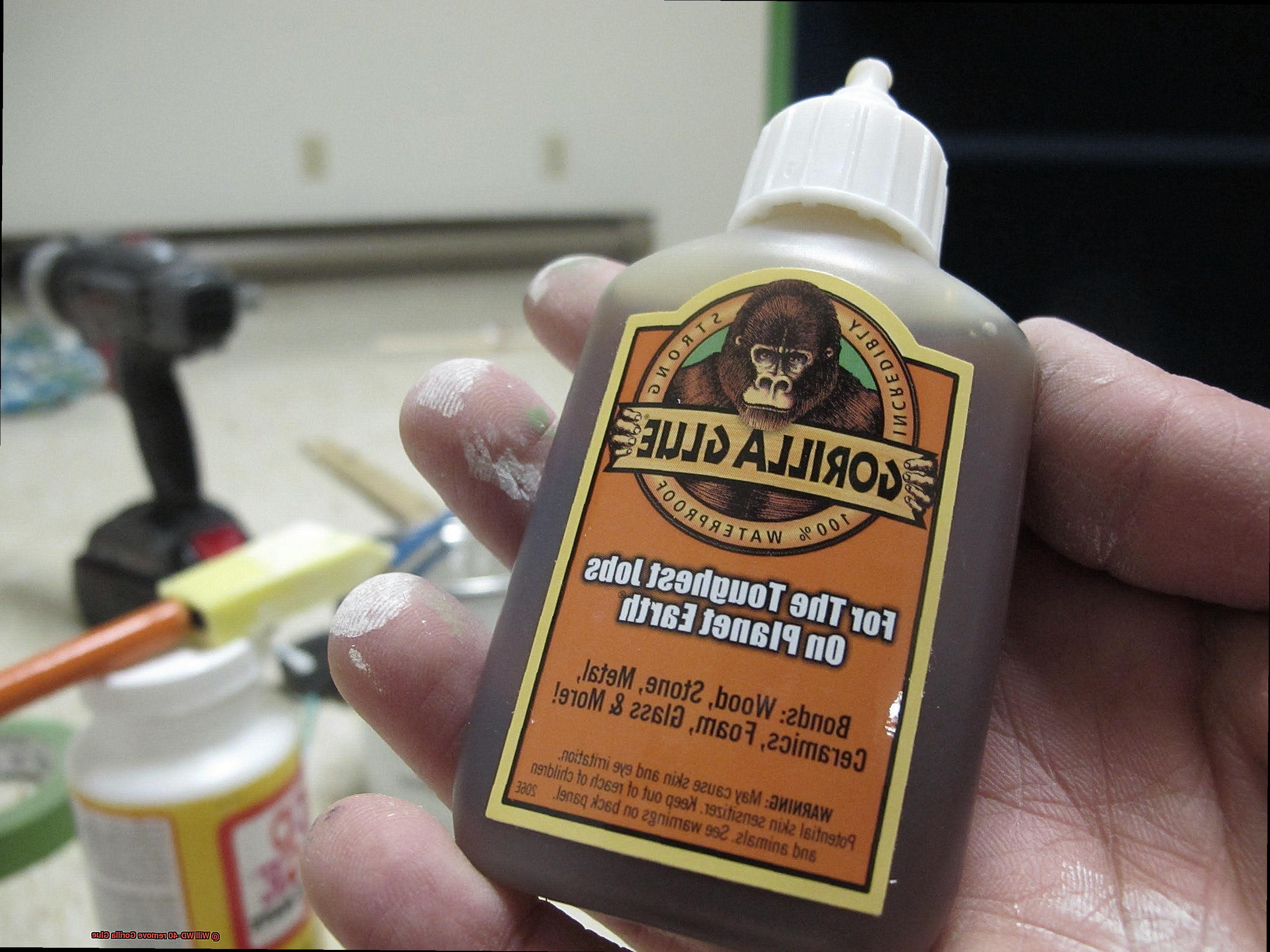
WD-40 may just be the solution you need. However, it is important to use it correctly to remove the glue effectively. Here are five simple steps on how to use WD-40 to remove Gorilla Glue.
Prepare the Surface
Before applying WD-40, it’s crucial to prepare the surface by removing as much excess glue as possible using a scraper or putty knife. This will make it easier for the lubricant to penetrate the glue and loosen its bond. Make sure to be careful while using sharp tools and not damage the surface underneath.
Apply WD-40
Spray a generous amount of WD-40 onto the affected area and let it sit for at least 10-15 minutes or longer if needed. This will give the lubricant enough time to penetrate the glue and loosen its bond effectively.
Scrub Gently
After letting it sit, gently scrub the area with a soft-bristled brush or clean cloth until the glue starts to loosen. Avoid scrubbing too hard as this may damage the surface underneath. If needed, repeat this process until all of the glue has been removed.
Be Cautious
It is crucial to remember that not all types of Gorilla Glue can be removed with WD-40 alone. Always proceed with caution and test a small, inconspicuous area before attempting to remove the glue from a larger surface. It is better to be safe than sorry.
Safety First
Lastly, always wear protective gloves and work in a well-ventilated area while using chemicals like WD-40. The fumes from the lubricant can be harmful if inhaled, so make sure there is proper ventilation while using it. Also, keep in mind that WD-40 is flammable, so make sure to use it away from any flames or heat sources.
Pros and Cons of Using WD-40 to Remove Gorilla Glue
While WD-40 may seem like a promising option, it’s essential to consider the pros and cons before using it.
One of the significant benefits of using WD-40 is that it can dissolve the glue, making it easier to remove. Additionally, it’s a more cost-effective choice compared to specialty glue removers. However, there are some potential downsides to using WD-40.
Firstly, it may not be effective on all surfaces or materials. If you’re unsure whether WD-40 is safe to use on a particular surface, it’s crucial to test a small area first. Secondly, WD-40 is flammable and must be used carefully to avoid accidents. Make sure to work in a well-ventilated area and wear protective gloves. Thirdly, it may leave behind an oily residue, which can be challenging to clean up.
Another potential risk of using WD-40 is that it may damage delicate or porous surfaces such as fabrics or specific types of wood. If you’re concerned about damaging the surface, it’s best to try an alternative method or seek professional help.
Alternative Methods for Removing Gorilla Glue
Gorilla Glue is a formidable adhesive that can make removing it seem like an impossible task. But don’t worry, there are alternative methods you can try if WD-40 fails to do the trick.
One option is to use acetone, which can be found in nail polish remover or paint thinner. However, be cautious as acetone can damage some surfaces. Before applying it to the glue, test it on a small, inconspicuous area first. If all goes well, it should dissolve the glue quickly.
Another alternative method is the use of rubbing alcohol or isopropyl alcohol. This method is best suited for smaller areas and can be applied with a cotton ball or Q-tip. It may take some patience and several applications before the glue dissolves completely.
If neither of these methods works, you could try physically scraping away the glue with a razor blade or sandpaper. However, this approach should only be used on surfaces that won’t be damaged by the scraping.
Prevention is always better than cure when it comes to Gorilla Glue. Use the adhesive carefully, avoiding any spills or spreading onto unintended areas. Properly storing the glue in a cool and dry place can prevent it from drying out and becoming difficult to work with.
Li3_SpYup18″ >
Conclusion
In the end, tackling Gorilla Glue may seem like an insurmountable challenge, but with a bit of know-how and some elbow grease, it’s possible to conquer this sticky situation. WD-40 is a versatile product that has been known to work wonders on all sorts of surfaces, but its effectiveness in dissolving Gorilla Glue hinges on the material and surface it’s affixed to. Before applying WD-40, it’s crucial to prep the area by removing as much excess glue as possible.
Once you’re ready to apply WD-40, be sure to take safety precautions such as wearing protective gloves and working in a well-ventilated space. Let the product sit for several minutes before gently scrubbing with a soft-bristled brush or clean cloth until the glue starts to loosen.
But if WD-40 isn’t doing the trick or isn’t suitable for your surface, don’t fret. Other solvents like acetone or rubbing alcohol can be used instead. Just remember to test a small area first before using it on the entire surface.
Of course, prevention is always better than cure when dealing with Gorilla Glue. Properly storing your adhesive in a cool and dry place can prevent it from drying out and becoming difficult to work with.


